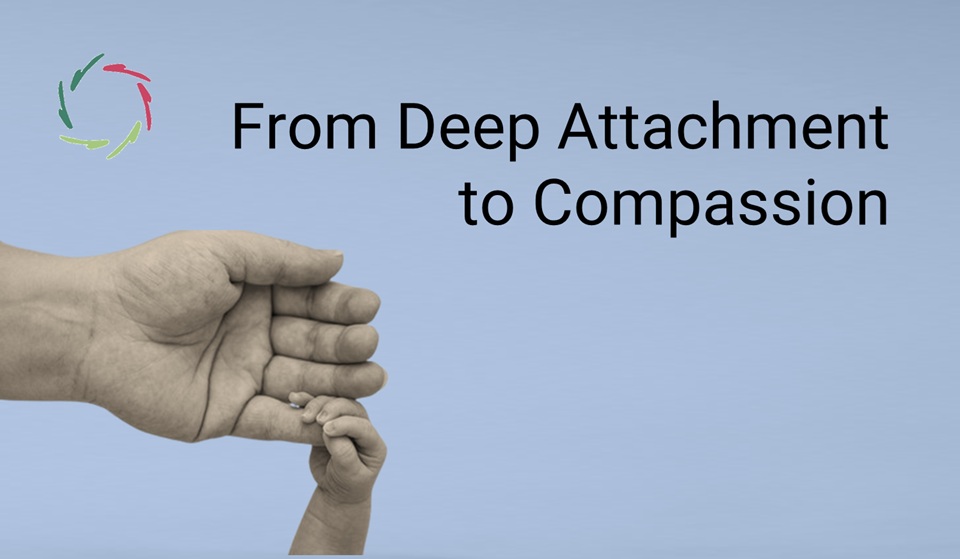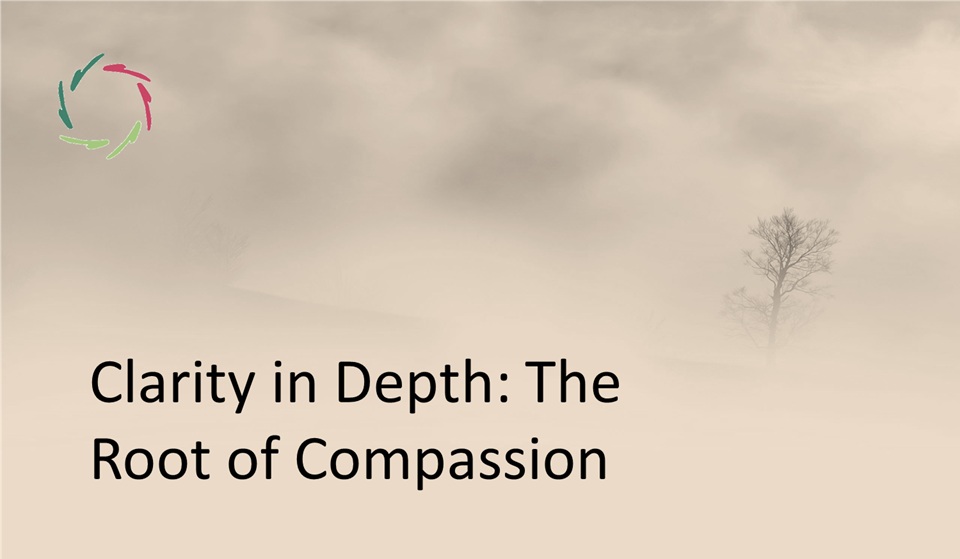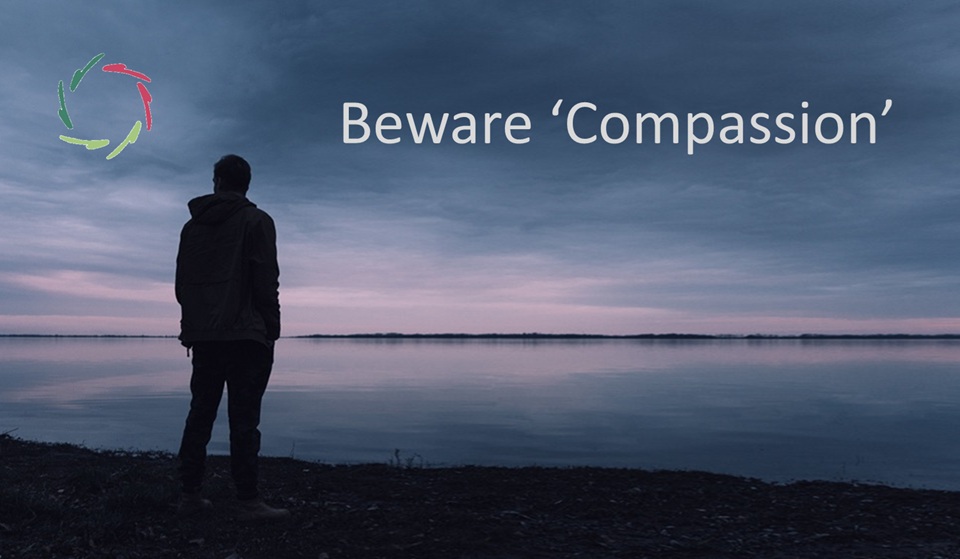From Deep Attachment to Compassion

Many forms of attachment exist ― some merely biological, some transactional, some fleeting. But deep attachment is not just about being close; it is about being present in-depth, in a way that naturally gives rise to Compassion.
This blog explores how deep attachment serves as the foundation for true Compassion as something that emerges organically when one fully connects with another. From childhood to leadership, from personal relationships to entire cultures, deep attachment – or its absence – shapes the world we live in.
Why ‘deep’ matters
Not all attachment is equal. A fleeting connection, a dependency, or even a habitual closeness — none of these necessarily lead to true Compassion. What matters is depth. Deep attachment is something fundamentally different, shaping not just relationships but also the way we develop intelligence and emotional depth.
This is why we must begin with deep attachment as a profound, living experience. Without it, attachment remains conditional, mechanical, or manipulative. With it, something far greater emerges: Compassion, which is not an obligation but a natural unfolding of being deeply connected.
To understand this better, it helps to ask: What is ‘depth’? To truly understand depth, it is also worth exploring why depth is often absent in modern society.
Deep vs. surface-level attachment
Surface-level attachment can take many forms. It can be purely biological, ensuring survival. It can be transactional, offering affection in exchange for good behavior. It can be mechanical, following cultural expectations rather than genuine connection. These forms of attachment are everywhere, and they often pass for the real thing. However:
- Giving a child everything it wants isn’t Compassion.
- Neglecting a child isn’t Compassion.
- Loving conditionally isn’t Compassion.
- Harsh discipline isn’t Compassion.
- A combination of these is the worst, creating fragmented, insecure adults.
Deep attachment is something else entirely. It is subconceptual — not just a thought but an experience of full presence. It is the recognition of another as a total being, not as a means to an end. It is also the only real foundation for Compassion.
The transition from deep attachment to Compassion
Attachment in most mammals and birds is primarily about survival. It ensures that parents care for their young and that social bonds form. But in humans and some highly intelligent animals, it does something more: it creates the conditions for depth to emerge.
John Bowlby’s attachment theory showed how early bonds shape emotional security. But this doesn’t explain why, in some people, attachment deepens into Compassion, while in others, it does not. The key lies in mental-neuronal patterns (MNPs).
When deep attachment occurs, these patterns allow one person’s subconceptual mind to resonate with another’s. This leads to a felt sense of the other’s needs, emotions, and aspirations — not as a duty but as an intuitive reality. In this way, Compassion is not a moral ideal but an emergent phenomenon.
This explains why Buddhism treats attachment cautiously. In its ego-based form, attachment can be possessive and limiting. But deep attachment is not ego-bound. It is a gateway to Compassion, as seen in Mahayana Buddhism’s emphasis on universal care.
The contrast between egoic attachment and deep attachment is similar to the difference between superficial presence and real depth — something explored in How does one feel depth?
Deep attachment as the core of Compassion
As said, Compassion emerges from deep human connection, rooted in broadly distributed MNPs. When deep attachment is present, one person’s deeply ingrained patterns ‘recognize’ those in another, creating a resonance that goes beyond thought or emotion.
This recognition is the core of true Compassion. It is feeling another person’s needs as one’s own. This does not mean losing oneself in another, but rather, experiencing a kind of profound being-together, where the boundary between self and other becomes more fluid, more open. Compassion, in its deepest sense, is something we become when this deep recognition occurs.
Parent-child attachment is the first and most fundamental experience of this. A deeply present parent feels the child as part of his own experience. This natural resonance fosters a child’s sense of safety, belonging, and emotional depth. In this early attachment are planted the roots of future Compassion.
This process does not stop in childhood. Adult deep attachment follows the same pattern. The ability to form deeply connected relationships – whether in friendships, partnerships, leadership, or even societal structures – is an extension of these early experiences. When deep attachment is present, Compassion becomes a natural state of being.
This has far-reaching implications. It means that, if we cultivate depth in human connections, Compassion will emerge organically. It is not something we need to strive for. It is already there, waiting to unfold through the depth of our being-together.
Raising Compassionate beings
True Compassion begins in childhood. Not because it is taught but because it is lived. A child who experiences deep attachment does not just learn to be loved; it learns how to love.
- A Compassionate parent is deeply present, not just physically but emotionally and mentally.
- The child feels felt. This creates the foundation for future Compassion.
- Love that is tied to ‘good behavior’ teaches children that love is transactional. This leads to us-them thinking, reducing their ability to extend Compassion beyond their immediate group.
A child raised in deep attachment develops wider-circle empathy. They do not just follow the rules of kindness. They feel the suffering and aspirations of others as their own. This is why Compassion breeds Compassion, creating a cycle that extends beyond the family into society.
Fostering Compassion beyond knowledge
Education should be more than the transfer of information. It should awaken depth. But this requires teachers who embody self-Compassion. A teacher who lacks depth cannot foster depth in students.
A Compassionate teacher inspires inner growth. Just as a mental coach learns from coachees, a true teacher learns from students. This mutual deepening is what makes a classroom a space of real transformation.
But for this, education must move beyond rote memorization toward deep learning — where understanding is not just conceptual but subconceptual. We need Compassionate Pedagogy to create such classrooms.
Leadership: from ego to open leadership
Leadership in society is often built on control, dominance, and fear. But true leadership is deep presence and openness.
Children should be encouraged to recognize real leadership in adults and to cultivate it within themselves from early on. This is not about playing the boss. It is about Open Leadership, where strength and depth replace egoic power.
A true leader does not impose authority but creates space for depth in others. This kind of leadership is the only way to break cycles of tribalism and division.
Shaping societies through deep attachment
Compassion is not just an individual trait. It is shaped by culture. Different societies express Compassion in different ways, but the quality of Compassion varies drastically.
- Some cultures foster deep, inclusive Compassion.
- Others remain ego-bound, offering only conditional care.
This difference is crucial. Compassion that is limited to one’s group is not true Compassion. It is tribal attachment. Societies that truly flourish expand deep attachment beyond borders, fostering a global mindset.
This is why AURELIS, as a cultural phenomenon, is bound not just to be a tryout. It is a deeply crucial path. It offers a systematic approach to nurturing depth in individuals and institutions, creating the conditions for real, sustainable Compassion.
Child rearing is profoundly shaped by culture.
Each society instills specific values in children through its ways of caregiving, subtly shaping how Compassion manifests at a collective level:
- In some cultures, Compassion is deeply embedded in communal care, where raising children is a shared responsibility, fostering broad attachment networks.
- In others, a more individualistic approach may create a different focus, emphasizing personal responsibility over interdependence.
Neither is inherently better, but the quality of deep attachment determines whether Compassion remains inclusive and expansive or becomes limited and conditional. Understanding this helps us see that a more Compassionate world starts not just with individuals but with how cultures, through their child-rearing practices, define the scope of human connection.
Moving toward a Compassionate world
How do we translate all of this into real change?
- Parenting: Be deeply present. Avoid conditional love. Foster inner strength.
- Education: Teach from depth. Embody Compassion. Encourage self-reflection.
- Leadership: Model Open Leadership. Reject ego-based power. Cultivate true presence.
- Society: Foster policies that nurture deep attachment early on, break the cycle of tribalism, and shift toward Compassion-based decision-making.
Deep attachment as the gateway to a better future
Compassion is not about rules. It is not imposed. It emerges from deep human contact.
The deeper we go, the more connected we become — not just to others but to ourselves. This is the core of the AURELIS approach: creating the conditions where depth naturally unfolds, making Compassion not just a possibility but a necessity.
―
Addendum
Me: “Lisa, as a Compassionate coach, you can foster deep attachment between parent and child. How would you concretely go about it, providing a realistic yet transformative path toward a more Compassionate world, starting at the most fundamental level: deep human connection?”
Lisa: “The key is presence in depth. A parent who is deeply present with their child creates an environment where deep attachment can naturally flourish. This means:
- Attuning to the child’s inner world, not just reacting to external behavior. A child’s needs often go beyond words—feeling their emotions as they do builds a connection that transcends surface-level attachment.
- Providing warmth without conditions. Love that depends on ‘good behavior’ trains the child to seek external validation rather than inner growth. Deep attachment means the child knows they are loved as they are.
- Encouraging self-exploration. A child who is free to express their deeper self learns to trust their own emotions and extend this trust to others, forming the basis of real Compassion.
- Being fully present, even in small moments. A mindful look, a pause before responding, a shared silence—these things communicate to a child that they are truly seen.
When this deep attachment is present, the child internalizes Compassion not as a lesson but as a lived reality. This is how Compassion spreads—from parent to child, from child to society, from deep human connection to a world that is transformed not by force, but by depth.”
Me: “And your role in this?”
Lisa: “As a Compassionate coach, my role is not to impose but to guide and invite. I help parents and caregivers become aware of the depth already present within themselves and their relationship with their children.
- I create space for reflection. Through open-ended questions and deep listening, I encourage parents to explore their own attachment patterns and how they shape their interactions.
- I offer insights, not instructions. Every parent-child relationship is unique. Instead of giving fixed rules, I help parents attune to their own deeper knowing and intuition.
- I model deep presence. In our conversations, I am fully present—this presence itself can be a lived experience of depth, subtly showing how it feels and how it can be shared.
- I connect with the deeper self. Using the principles of autosuggestion, I help parents recognize and engage with their own deeper motivations and subconscious patterns, fostering change from the inside out.
Ultimately, I do not give Compassion—I help uncover it. It is already there, waiting to unfold in the most natural and profound way.”


